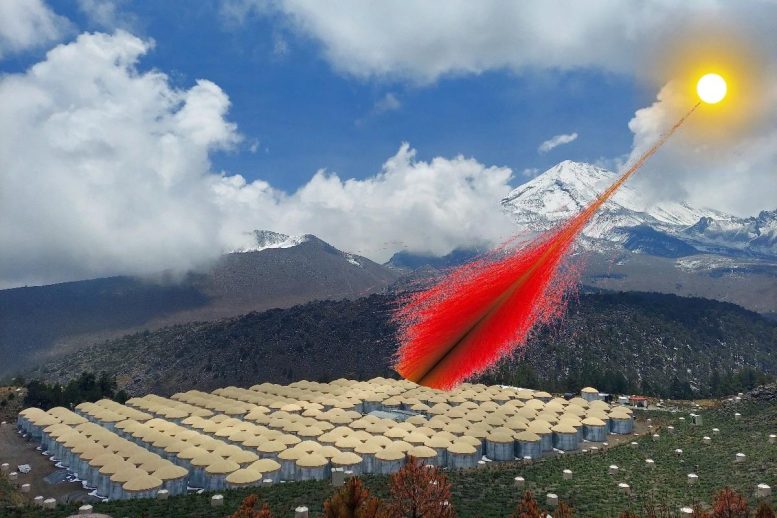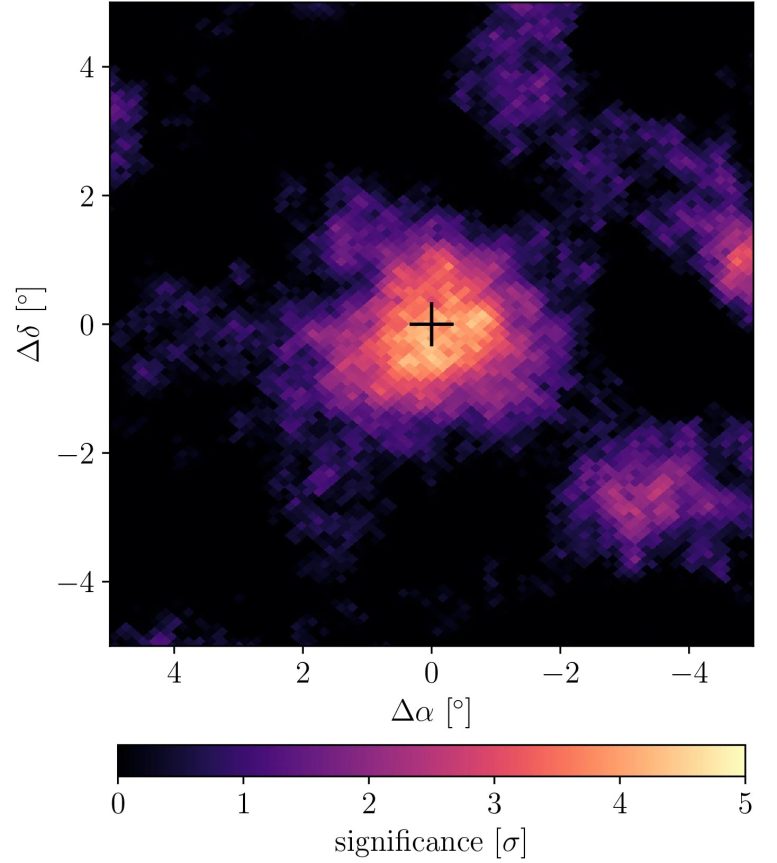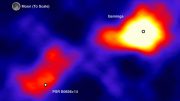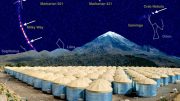
Researchers at Michigan State University have discovered the highest-energy light, or gamma rays, from the sun using the High-Altitude Water Cherenkov Observatory (HAWC). The surprisingly abundant and bright gamma rays pose new questions about our understanding of the sun and its high-energy processes.
Astrophysicists reveal the sun is beaming down gamma rays with energies higher than ever measured.
- The gamma rays lose energy in Earth’s atmosphere, meaning they don’t present a concern to life. This also allows them to be discovered by researchers working with the High-Altitude Water Cherenkov Observatory, or HAWC, located in Mexico.
- “This shows that HAWC is adding to our knowledge of our galaxy at the highest energies, and it’s opening up questions about our very own sun,” said Mehr Un Nisa, a postdoctoral researcher with MSU and the corresponding author of the new report.
Sometimes, the best place to hide a secret is in broad daylight. Just ask the sun.
“The sun is more surprising than we knew,” said Mehr Un Nisa, a postdoctoral research associate at Michigan State University. “We thought we had this star figured out, but that’s not the case.”
Nisa, who will soon be joining MSU’s faculty, is the corresponding author of a new paper in the journal Physical Review Letters that details the discovery of the highest-energy light ever observed from the sun.
The international team behind the discovery also found that this type of light, known as gamma rays, is surprisingly bright. That is, there’s more of it than scientists had previously anticipated.

Michigan State University belongs to the collaboration using the High-Altitude Water Cherenkov Observatory in Mexico to study high-energy phenomena in our galaxy. Credit: Jordan A. Goodman
Watching Like a HAWC
Although the high-energy light doesn’t reach the Earth’s surface, these gamma rays create telltale signatures that were detected by Nisa and her colleagues working with the High-Altitude Water Cherenkov Observatory, or HAWC.
Funded by the National Science Foundation and the National Council of Humanities Science and Technology, HAWC is an important part of the story. Unlike other observatories, it works around the clock.
“We now have observational techniques that weren’t possible a few years ago,” said Nisa, who works in the Department of Physics and Astronomy in the College of Natural Science.
“In this particular energy regime, other ground-based telescopes couldn’t look at the sun because they only work at night,” she said. “Ours operates 24/7.”

Michigan State University postdoctoral researcher Mehr Un Nisa at the High-Altitude Water Cherenkov Observatory. Credit: Courtesy of Mehr Un Nisa
HAWC: A Different Kind of Telescope
In addition to working differently from conventional telescopes, HAWC looks a lot different from the typical telescope.
Rather than a tube outfitted with glass lenses, HAWC uses a network of 300 large water tanks, each filled with about 200 metric tons of water. The network is nestled between two dormant volcano peaks in Mexico, more than 13,000 feet above sea level.
From this vantage point, it can observe the aftermath of gamma rays striking air in the atmosphere. Such collisions create what are called air showers, which are a bit like particle explosions that are imperceptible to the naked eye.
The energy of the original gamma ray is liberated and redistributed amongst new fragments consisting of lower energy particles and light. It’s these particles — and the new particles they create on their way down — that HAWC can “see.”
When the shower particles interact with water in HAWC’s tanks, they create what’s known as Cherenkov radiation that can be detected with the observatory’s instruments.

A composite image shows a photograph of the High-Altitude Water Cherenkov Observatory in Mexico observing particles, whose paths are shown as red lines, generated by high-energy gamma rays from the sun. Michigan State University researchers were part of the team that observed those particles and gamma rays. Credit: Mehr Un Nisa
Pioneering Research
Nisa and her colleagues began collecting data in 2015. In 2021, the team had accrued enough data to start examining the sun’s gamma rays with sufficient scrutiny.
“After looking at six years’ worth of data, out popped this excess of gamma rays,” Nisa said. “When we first saw it, we were like, ‘We definitely messed this up. The sun cannot be this bright at these energies.’”
The sun gives off a lot of light spanning a range of energies, but some energies are more abundant than others.
For example, through its nuclear reactions, the sun provides a ton of visible light — that is, the light we see. This form of light carries an energy of about 1 electron volt, which is a handy unit of measure in physics.
The gamma rays that Nisa and her colleagues observed had about 1 trillion electron volts, or 1 tera electron volt, abbreviated 1 TeV. Not only was this energy level surprising, but so was the fact that they were seeing so much of it.

What an excess of solar gamma rays looks like to the High-Altitude Water Cherenkov Observatory Collaboration, which includes researchers from Michigan State University. Credit: Courtesy of the HAWC Collaboration
A History of Gamma Ray Discovery
In the 1990s, scientists predicted that the sun could produce gamma rays when high-energy cosmic rays — particles accelerated by a cosmic powerhouse like a black hole or supernova — smash into protons in the sun. But, based on what was known about cosmic rays and the sun, the researchers also hypothesized it would be rare to see these gamma rays reach Earth.
At the time, though, there wasn’t an instrument capable of detecting such high-energy gamma rays and there wouldn’t be for a while. The first observation of gamma rays with energies of more than a billion electron volts came from NASA’s Fermi Gamma-ray Space Telescope in 2011.
Over the next several years, the Fermi mission showed that not only could these rays be very energetic, but also that there were about seven times more of them than scientists had originally expected. And it looked like there were gamma rays left to discover at even higher energies.
When a telescope launches into space, there’s a limit to how big and powerful its detectors can be. The Fermi telescope’s measurements of the sun’s gamma rays maxed out around 200 billion electron volts.
The HAWC Collaboration
Theorists led by John Beacom and Annika Peter, both professors at Ohio State University, encouraged the HAWC Collaboration to take a look.
“They nudged us and said, ‘We’re not seeing a cutoff. You might be able to see something,” Nisa said.
The HAWC Collaboration includes more than 30 institutions across North America, Europe, and Asia, and a sizable portion of that is represented in the nearly 100 authors on the new paper. That includes three additional Spartans: graduate student Daniel Salazar-Gallegos, Professor Emeritus James Linnemann, and Kirsten Tollefson, a professor of physics and astronomy and associate dean in the Graduate School at MSU.
Now, for the first time, the team has shown that the energies of the sun’s rays extend into the TeV range, up to nearly 10 TeV, which does appear to be the maximum, Nisa said.
Currently, the discovery creates more questions than answers. Solar scientists will now scratch their heads over how exactly these gamma rays achieve such high energies and what role the sun’s magnetic fields play in this phenomenon, Nisa said.
When it comes to the cosmos, though, that’s part of the excitement. It tells us that there was something wrong, missing or perhaps both when it comes to how we understand our nearest and dearest star.
“This shows that HAWC is adding to our knowledge of our galaxy at the highest energies, and it’s opening up questions about our very own sun,” Nisa said. “It’s making us see things in a different light. Literally.”
Reference: “Discovery of Gamma Rays from the Quiescent Sun with HAWC” by A. Albert et al. (HAWC Collaboration), 3 August 2023, Physical Review Letters.
DOI: 10.1103/PhysRevLett.131.051201









“Light” is a region of the electromagnetic spectrum near the peak output of the sun, and the peak transmission of Earth’s atmosphere, which allows organisms that have evolved eyes to focus and perceive the emissions of those wavelengths.
What is being discussed is highly energetic electromagnetic radiation that has wavelengths intermediate between X-rays and Cosmic Rays. It is very difficult to focus because it can penetrate most solid materials, and is destructive to living organisms.
The world scientists is fool. They spends dollar for that’s work which not giving single information. One day will be come that’s no body can’t handle its that’s day is our last day of earth,
I requested to nasal prove in earth that’s all people life safe and help in everything’s.
You are lost buddy. No one knows what you are talking about.
Is it worth showing off as a corresponding author of a new paper in the journal Physical Review Letters ?
Physical Review Letters adheres to a pseudoscientific stance and is stubborn. Here’s why.
1. If we don’t understand how θ & τ was formed, there will be no clear evidence to infer parity violation of them in weak interaction.
2. There is no clear evidence to suggest that two sets of cobalt-60 can be transformed into symmetry by rotating in opposite directions. Similarly, the motion of two hydrogen atoms – electrons around the nucleus – may not necessarily be symmetrical at the same time, even via reverse rotation.
Undoubtedly, the inference of parity violation in weak interaction is pseudoscience.
Science will eventually return to the right track, and it will not change due to the misleading nature of the Physical Review Letters.
This has been going on for nearly 4 years and only now they figured it out.
So we (Humans), don’t understand our own sun, but you expect us to believe in dark matter. Dark matter does not exist. JWT has proven that beyond any doubt.
Working outside the sun just seems stronger than usual. In my opinion it is likely responsible for the higher temperatures this year. It is likely that perhaps there are even yet more emissions that are yet to be understood coming from the sun.
I highly doubt that these gamma rays only recently started to be emitted. But nice attempt at BSing a denial of the common theory on climate change.
your adds make this article unreadable. I spent far to much time trying to readjust the screen that j gave up in the end 🖕
This article is a joke they are just trying to say some absolute ridiculous crap if you believe this then Your an idiot because what’s really going on is a directed energy beam from haarp or wherever from an array of antennas juicing unimaginable amounts of electricity to anywhere they want.Our world is about to be bombarded with manmade catastrophic weather they are going to incinerate life just like they did in Maui causing, triggering earthquakes,tnusamis, drought,ect….. Global warming my a** these bastards are sick and plan on wiping out humanity…Biden needs a bullet in his head this year is going to be the year that alot of major events will occur either ww3,Hoover Dam will get hit by this energy beam next mark my words I hate to say it but it’s been decoded through my research and knowledge of the ones who like hiding in plain site
How can you say dark matter doesn’t exist.they just found demon matter and that was in our face for years.let science prove its self and in defense technology has came so far in the last 50 years it’s changed everything and that’s going back thousands and thousands of years.20 years from now we’re will be science and technology welcome to the Jetsons.get on board
How can you say dark matter doesn’t exist.they just found demon matter and that was in our face for years.let science prove its self and in defense technology has came so far in the last 50 years it’s changed everything and that’s going back thousands and thousands of years.20 years from now we’re will be science and technology welcome to the Jetsons.get on board.